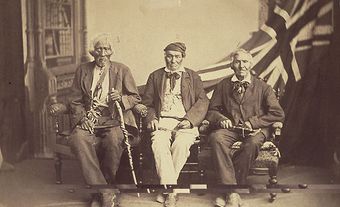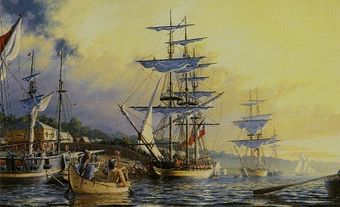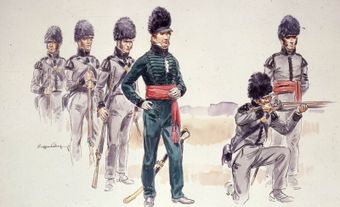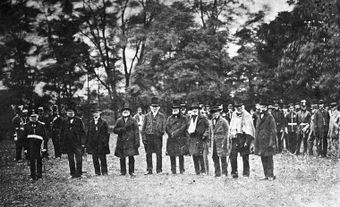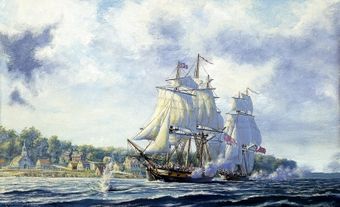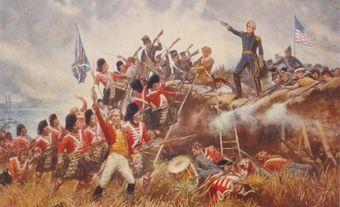The Battle of Lake Erie was a naval battle fought by the United States Navy and the British Royal Navy on 10 September 1813 in western Lake Erie during the War of 1812. Also known as the Battle of Put-in-Bay, the battle was an American victory. The event was unique in naval combat history because it was fought on an inland, freshwater sea, and it marked a turning point in the affairs of the two competing powers in the continental heartland and in waters above Lake Erie. It also had an impact on First Nations, notably on the ill-fated pan-Indigenous alliance headed by the Shawnee war chief, Tecumseh.

Engagement at Put-in-Bay
British forces under Major General Isaac Brock took Detroit at the outset of the war, and in doing so secured their flank into the Ohio country. This gave them immense advantages, as did the capture of Fort Michilimackinac on Lake Huron. Lake Erie was vital to the British as a supply route for their western army, the trade of the North West Company and for their Indigenous allies. Subsequently, the British and Americans built naval squadrons on Lake Erie.
The British squadron sailed forth from its base in Amherstburg, Upper Canada, and found the American fleet at dawn at anchor in Put-in-Bay of the Bass Islands (Ohio). The out-gunned and smaller British fleet consisted of six naval vessels (Detroit, Queen Charlotte, Lady Prevost, General Hunter, Little Belt and Chippeway) and was under the command of Commodore Robert Barclay. The American fleet consisted of nine vessels (Lawrence, Niagara, Caledonia, Ariel, Somers, Porcupine, Tigress, Scorpion and Trippe) under the command of Commodore Oliver Hazard Perry. Wind direction and speed soon did not favour the British. When the Americans put to sea, they were advantageously situated to windward of the British vessels. The fleets formed up in such a way that the more powerful vessels on either side were opposite each other.

The Battle
At 11:45 am, the action started when Barclay in the Detroit opened with long guns. Perry in the Lawrence, supported by two schooners, attacked the Detroit and soon thereafter, attacked the Queen Charlotte. The American brigs' heavy and long gunnery wreaked havoc on the British vessels. The Detroit was lost and all other vessels damaged, their sails entangled or otherwise out of the action. The Lawrence was also heavily damaged, and therefore Perry shifted his flag to the Niagara.
The battle ceased at 2:30 pm. All British ships were captured and all the surviving officers and men made prisoner. British losses numbered 41 dead, 94 wounded and 306 captured. American casualties were 27 dead and 96 wounded. The captured pennants of the British ships were taken to Annapolis, Maryland, to be put on display.

Reasons for American Victory on Lake Erie
The reasons for the American victory were determined at Barclay's court martial as a lack of resources – both equipment and personnel – as well as the superiority of the American squadron and the unfortunate early fall of the British higher-ranking officers in the action. The court martial noted Barclay's great exertions in readying his ships for action and stated that he was fully justified in taking his squadron into action. He and his surviving officers and men were honourably acquitted.

Consequences of the Battle of Lake Erie
The victory gave the Americans the command of Lake Erie and with it, freedom of action in subsequent military operations. Major General Henry Procter, the senior British commander, with few means of getting supplies, ordered Fort Amherstburg burned and fell back up the Thames River. Tecumseh, who was allied with Procter, understood what the naval defeat meant to his pan-Indigenous alliance, and also fell back in company with the British army. US Major General William Henry Harrison gave chase and met up with Procter and Tecumseh near Moraviantown. During the Battle of Moraviantown, the British suffered another defeat and Tecumseh was killed.
Units of the American fleet, stronger than ever, sailed north into Lake Huron and in 1814 undertook various operations there, searching out surviving enemy shipping (the Nancy was destroyed at the Nottawasaga River; see Nancy Island Historic Site), raiding Sault Ste Marie and attempting unsuccessfully to recapture Fort Michilimackinac. The flagship Niagara became emblematic of American naval prowess and is now part of the museum at Erie, Pennsylvania.

 Share on Facebook
Share on Facebook Share on X
Share on X Share by Email
Share by Email Share on Google Classroom
Share on Google Classroom
